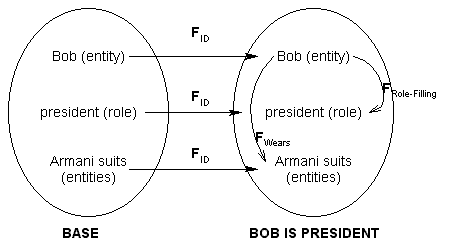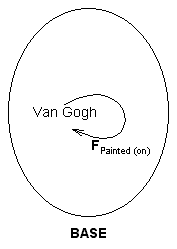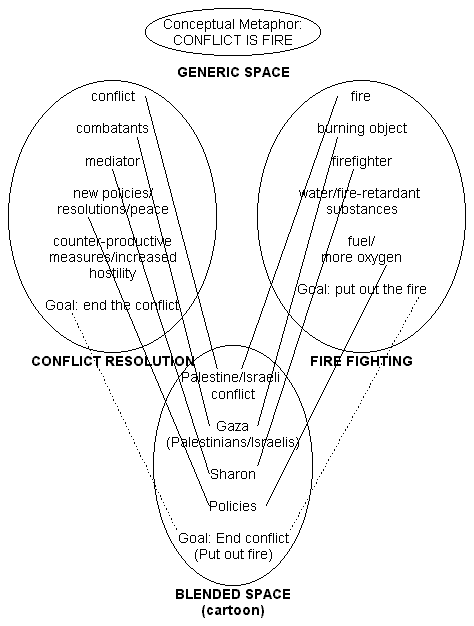
Bob is so vain that if he were president, he would wear Armani suits.
According to this sentence, Bob is very vain. If he were president and had a lot of money (which, probably, he doesn't currently have), he would buy and wear Armani suits simply because he is vain. There are two mental spaces invoked here--the base space and the space in which Bob is president. In the base/reality space, there is Bob, the role of president, and Armani suits. In the "Bob is president" space, there also exists Bob, the president role, and Armani suits. However, here Bob is the person filling the president role, and Bob wears Armani suits. This is summed up in the diagram below. Not shown is the fact that Bob is vain. This is the case in both spaces.

Rick believes that my wife thinks I have trust issues, but what he doesn't know is that she's actually trying to kill me.
In this sentence, Rick mistakenly believes that my wife thinks I have trust issues. In actual fact, my wife is trying to kill me (and doesn't give a damn about my trust issues). This interpretation produces two primary mental spaces--the space of Rick's beliefs and the base/reality space. Rick's beliefs also includes a space of what my wife thinks. In the base space, my wife is trying to kill me. In Rick's beliefs, there is my wife (he believes she exists) and the space of what Rick believes my wife thinks. In this embedded space, my wife thinks I have trust issues (and is not trying to kill me.)

The current interpretation assumes that the speaker really knows what is going on and is not delusional himself; otherwise, there would be a space for his beliefs too. Other interpretations are of course possible--such as whether my wife thinks I have trust issues while she's still trying to kill me, etc.
Van Gogh painted himself.
This sentence provokes two main possible meanings. In the first, Van Gogh painted a picture of himself. In the second, he used his own body as a canvas.
In the first case, we have two spaces--base/reality and the space of the picture painted by Van Gogh. The subject of this painting is Van Gogh', an image of the real Van Gogh. The real Van Gogh produces the image of the painted Van Gogh.

In the second case, we have only the base/reality space. We have Van Gogh. He paints something (we know not what) on to his own body, using himself as a canvas.


This cartoon is a blending of two input spaces. The first is the Palestinian-Israeli conflict. Clues for this is the name and character Sharon (Prime Minister of Israel), the Star of David on his helmet, and the word "Gaza" (as in Gaza Strip, one of the Palestinian refuge areas). The other input space is that of firefighting. This is cued by the "firetruck", the firefighter uniform, and the smoke.
These two spaces are both frames. The first frame, conflict resolution, involves some sort of conflict, participants/combatants, mediators, new policies or resolutions, counter-productive measures, and a goal of ending the conflict. The second frame, firefighting, involves a fire, something that burns, a firefighter, water, fuel, and a goal of putting out the fire. These two frames map quite nicely in the order given here: conflict = fire, combatants = burning things, mediators = firefighters, etc. (See diagram for more.)
There is actually a metaphor--CONFLICT IS FIRE--that is being used here. We often talk about things "heating up" in the Middle East. Soldiers might talk about the action getting really "hot." Poor conflict management might "fan the flames" of a conflict. This metaphor is not terribly common, however, and the firefighter seems to be an extension of it.

Some of the lines have been omitted for clarity. The components of the conflict resolution space correspond to the component on the same line in the firefighting space, and vice versa. They are mapped through the generic space of the conceptual metaphor. The blended space is constructed from the components of the two contributing spaces. Though only the firefighting components are actually depicted in the cartoon, an understanding of both is needed to understand the conclusion. The smoke of a burning Gaza is shown. Sharon, a supposed mediator, is shown in the cartoon as a firefighter. Yet instead of using water, he's using gas. Thus, instead of putting out the fire, he's adding fuel. He is aggravating the conflict, rather than resolving it. Whether the goals map depends on your interpretation of the cartoon. If Sharon is merely misguided, and using methods that do not match the goal, then he is simply incompetent and goal of ending the conflict/fire maps. However, if you think he is intentionally pouring gas on the blaze, then he is malicious and has a different goal in mind. Either conclusion on Sharon's intentions, however, is an emergent property of the blended space.
| ~ztomasze Index:
CIS: Assignment 4 http://www2.hawaii.edu/~ztomasze |
Last Edited: 12 Nov 2002 ©2002 by Z. Tomaszewski. |